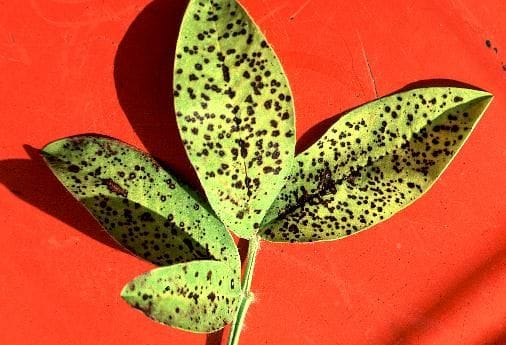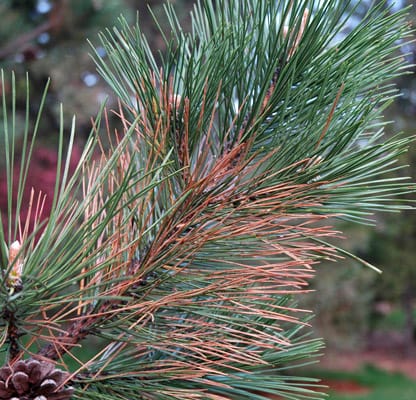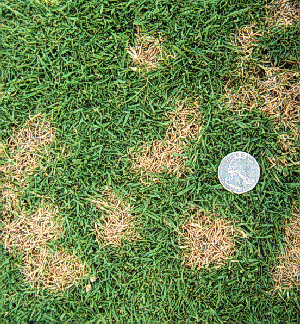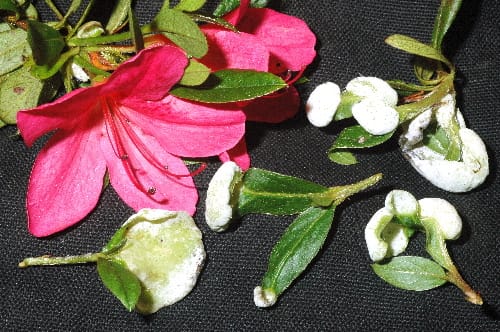Source(s): Laurene Hall
Leaf spot is a common descriptive term applied to a number of diseases affecting the foliage of ornamentals and shade trees. The majority of the leaf spots are caused by a variety of fungal pathogens, but some are caused by bacteria.

Leaf diseases, including rusts and various types of leaf spots are abundant at this time of year. The good news is these foliage diseases usually reduce only the aesthetic value of the affected tree. Occasionally, however, a severe outbreak may cause early leaf drop and dieback of tree parts. With repeated infection, trees become more susceptible to attack by other diseases, insects, and winter injury.
Correct identification is important, because leaf spot diseases can be easily confused with non-disease problems such as leaf scorch or other environmental abnormalities. If in doubt, bring a sample for identification to your County Cooperative Extension Service.
IDENTIFICATION
The primary symptom of a leaf spot disease is spots on foliage. The spots will vary in size and color depending on the plant affected the specific organism involved,and the stage of development. Spots can vary in color from red, purplish-brown, tan, or black. Concentric rings or a dark margin around the spot may be present. Fungal bodies may appear as black dots in the center of the spots. Over time the spots may combine to enlarge to form blotches. Leaves may yellow and drop prematurely.
Leaf rust is another common problem associated with fungal leaf diseases. It is characterized by yellow spots on the upper leaf surface. Close examination reveals small yellow-orange bumps filled with powdery spores on the leaves. As with leaf spot, rust infestations will become apparent in mid to late August.
APPEARANCE

Active in late spring to late autumn. The fungal and bacterial agents that cause Leaf diseases often exist naturally in the air and in our soils. The organisms that cause leaf spots survive in fallen infected leaves and twigs. Some may remain in dead twigs on the tree. During wet weather, spores are released which may splash or be windblown onto newly emerging tender leaves where they germinate in the moisture and infect the leaf. Overhead watering late in the day or during the night, heavy dews and close spacing of plants prolong wetting of the leaf surface and provide more opportunities for fungal or bacterial infections.
HOSTS
All species of trees, shrubs, and other ornamental plants can potentially develop leaf spots, but some species are more susceptible than others. It is the presence of the correct factors that will decide whether or not a plant will develop a Leaf disease from causal agents.
Three critical factors or conditions must exist for disease to occur — a SUSCEPTIBLE HOST, a PATHOGEN, and the right combination of POOR ENVIRONMENTAL CONDITIONS. The relationship of these factors is called the DISEASE TRIANGLE.
If only a part of the triangle exists, disease will not occur. Understanding the disease triangle helps us understand why most plants are not affected by the many thousands of diseases that exist.
In some cases, it is important to only acquire specific varieties of plants that exhibit a resistance to diseases that are particularly fatal.
INTEGRATED PEST MANAGEMENT (IPM) CONTROL
Live with the disease. Leaf spots are largely an aesthetic problem as few leaf spots seriously damage the host. Here are some steps to follow that will help control the disease after the infection has started.
- Remove infected leaves and dead twigs. The fungi responsible for these diseases survive the winter in leaf debris on the ground. Wet spring weather stimulates spore production. The spores are blown and splashed from the ground to developing leaves. Foliage diseases are cyclic: bad years coincide with long-term moist weather. Raking up and disposing of infected leaves as they drop and pruning out dead twigs can help control the disease by removing spores that can re-infect the new leaves. This will not cure the problem but it can help minimize infections.
- Keep foliage dry. Avoid overhead watering. Use soaker hoses or water early in the day so the foliage can dry before night. Watering can also spread the disease by splashing. Prune plants and space plants to allow for good air circulation that promotes rapid drying of foliage.
- Keep plants healthy. Since most plants can tolerate some defoliation, keep them in good health so they can rebound quickly. Avoid over fertilization as it promotes a flush of young leaves that are more susceptible to attack by insects and disease.
- Replace the plant. For plants that chronically are plagued by leaf spots, gardeners find it more convenient to replace a plant with a different species or a variety that is more resistant or tolerant of disease.
CHEMICAL CONTROLS
Use fungicides wisely. Chemical control is usually not necessary and often unsuccessful if the fungicide is not applied properly. It is usually impractical and not economically feasible for homeowners to spray fungicides on trees. This is because many trees that are affected by leaf diseases are well-established and too large to spray. Additionally, mature trees may naturally develop leaf diseases more frequently as a result of the stress of old age; consequently, if healthy enough, the tree may recover from a leaf disease on its own and without a homeowner’s intervention. In rare cases of severe infection where the size and value of plants make it practical, applications of fungicides may be helpful.
Generally fungicidal control is warranted if:
- repeated defoliations occur in one year or subsequent years;
- the plant is under stress or in serious decline and showing no signs of recovery with improved environmental conditions;
- or there is serious danger of infection spreading rampantly to other uninfected plants.
Sprays will not cure the infection but protect leaves from becoming infected. To be effective, fungicidal sprays must begin at bud break before symptoms are noted and be continued at intervals specified by the label (usually 10-14 days) through the period of spring rains. Spraying after the infection is present will provide little benefit. Recommendations will vary with the disease and fungicide used. It is always good practice to have the disease identified before purchasing a control product. If you think your plant is suffering from a Leaf disease, bring a sample of the leaves on a branch with both healthy and diseased tissue to the Extension Office for proper diagnosis. A fungicide recommendation may be given if the problem cannot be corrected by cultural IPM practices. Always carefully follow label directions when applying chemicals and wear protective clothing if necessary.
Resource(s): Common Landscape Diseases In Georgia
Center Publication Number: 47




